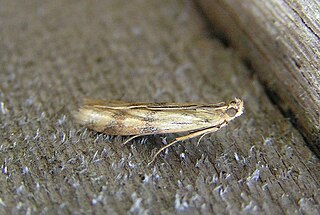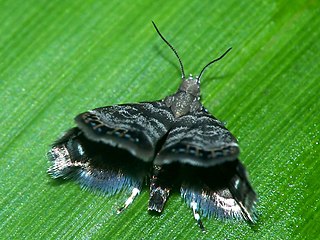
The Pyralidae, commonly called pyralid moths, snout moths or grass moths, are a family of Lepidoptera in the ditrysian superfamily Pyraloidea. In many classifications, the grass moths (Crambidae) are included in the Pyralidae as a subfamily, making the combined group one of the largest families in the Lepidoptera. The latest review by Eugene G. Munroe and Maria Alma Solis retain the Crambidae as a full family of Pyraloidea.
Agathiphaga is a genus of moths, known as kauri moths. and is the only living genus in the family Agathiphagidae. This caddisfly-like lineage of primitive moths was first reported by Lionel Jack Dumbleton in 1952, as a new genus of Micropterigidae.

Ephestia elutella, the cacao moth, tobacco moth or warehouse moth, is a small moth of the family Pyralidae. It is probably native to Europe, but has been transported widely, even to Australia. A subspecies is E. e. pterogrisella.

Homoeosoma sinuella is a moth of the family Pyralidae. It is found in Europe.
Assara albicostalis is a moth of the family Pyralidae. It has a wide distribution and has been recorded from India, Sri Lanka, Thailand, Sabah, the Philippines, Taiwan, Sulawesi, Australia, Fiji, Tahiti, Samoa, Hawaii and the Marquesas. This is the type species of genus Assara.

Garella nilotica, the black-olive caterpillar or bungee caterpillar, is a moth of the family Nolidae. It was described by Alois Friedrich Rogenhofer in 1881. It has a pantropical distribution, including the eastern North America, the Caribbean, the Iberian Peninsula, Australia, Guam, Fiji, Samoa, the Galápagos Islands and the Chagos Archipelago.

Homoeosoma is a genus of moths of the family Pyralidae.
Homoeosoma stenotea is a species of snout moth in the genus Homoeosoma. It was described by George Hampson in 1926. It is found in Zimbabwe and South Africa.
Homoeosoma inornatellum is a species of snout moth in the genus Homoeosoma. It was described by George Duryea Hulst in 1900. It is found in North America, including New Jersey and Pennsylvania.
Homoeosoma striatellum is a species of snout moth in the genus Homoeosoma. It was described by Harrison Gray Dyar Jr. in 1905. It is found in North America, including Arizona, California and Nevada.
Homoeosoma phaeoboreas is a species of snout moth in the genus Homoeosoma. It was described by R. L. Goodson and Herbert H. Neunzig in 1993. It is found in the western U.S. state of Washington.
Homoeosoma ardaloniphas is a species of snout moth in the genus Homoeosoma. It was described by R. L. Goodson and Herbert H. Neunzig in 1993. It is found in North America, including North Dakota.
Homoeosoma ammonastes is a species of snout moth in the genus Homoeosoma. It was described by R. L. Goodson and Herbert H. Neunzig in 1993. It is found in North America, including North Carolina.
Homoeosoma caradjellum is a species of snout moth in the genus Homoeosoma. It was described by Roesler in 1965. It is found in the Russian Far East.
Homoeosoma punctistrigella is a species of snout moth in the genus Homoeosoma. It was described by Ragonot in 1888. It is found in India, Israel and Russia.
Homoeosoma capsitanella is a species of snout moth in the genus Homoeosoma. It was described by Pierre Chrétien in 1911. It is found in the Palestinian territories and Israel.

Brenthia catenata is a species of moth of the family Choreutidae. It was described by Edward Meyrick in 1907. It is found in India, Sri Lanka, the Philippines and Samoa.

Tirumala hamata, the dark tiger, is a butterfly of the family Nymphalidae. It is distributed from the Philippines to Australia and Pacific oceanic islands such as Samoa. In Australia, the butterflies perform mass migrations to the south in some years. In April 1995, the butterfly made a rare migratory journey to New Zealand, coinciding with the appearance of Hypolimnas bolina on the islands.
Stictea ejectana, the guava bud moth, is a moth of the family Tortricidae. It was described by Francis Walker in 1863. It is found on Fiji, Samoa, the Marquesas Archipelago, Tahiti, Rapa Iti, the southern Mariana Islands, the Philippines and in New Caledonia, New Zealand and Australia.

Homoeosoma anaspila is a species of snout moth in the genus Homoeosoma. It is endemic to New Zealand. It found in the North and South Islands as well as the Kermadec Islands.






